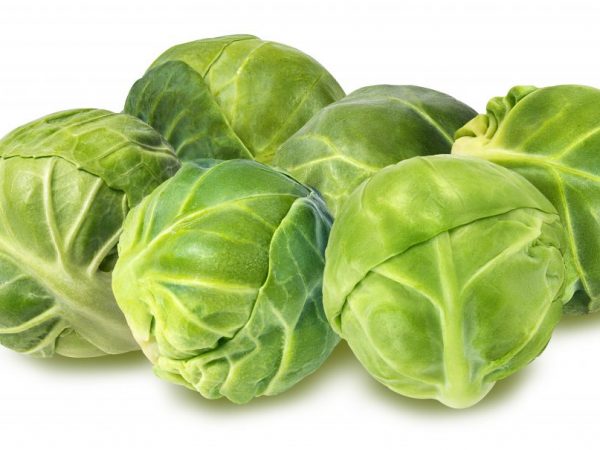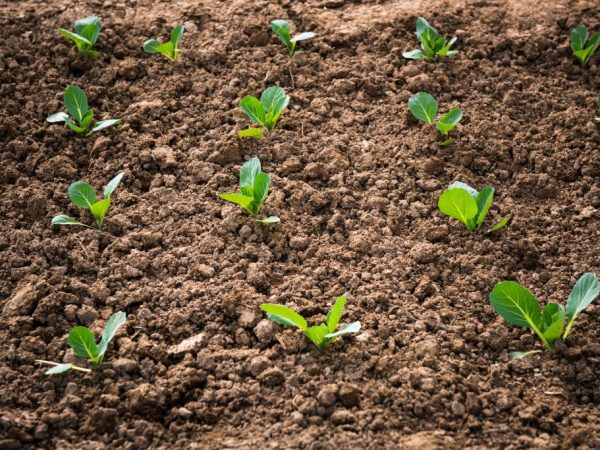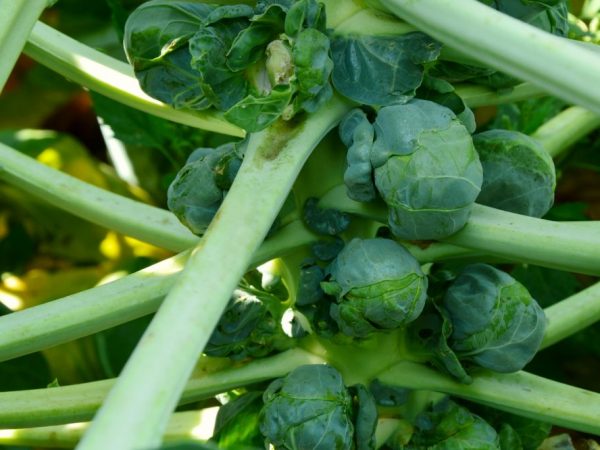Features of growing Brussels sprouts
Not every vegetable is capable of boasting excellent taste characteristics and an abundance of useful trace elements in its composition. To get a rich harvest, it is important to know the secrets of cultivation. Growing and caring for Brussels sprouts requires adherence to the intricacies of agricultural technology.

Features of growing Brussels sprouts
Description of the species
The culture of the cruciferous family does not occur in the wild; it is a product of selection.
The vegetable bred in Belgium was named after the capital of this state.
Popular cabbage varieties:
- Rosella;
- Sanda;
- Sapphire;
- Hercules.
The plant is biennial. The crop develops unusually: long leaves with pimples on the surface are located on a thick high stem. A rosette forms at the top, in the sinuses of which tiny heads of cabbage are formed (diameter - from 2 to 6 cm). On average, one bush can have from 25 to 75 fruits.
The culture blooms in the second year, after which the pods develop and the seeds ripen.
If Brussels sprouts are grown on their own plot, you do not need to worry about its survival rate. The subspecies is the most unpretentious and cold-resistant, withstands frosts down to -9 ° C. The crop has the longest growing season. Depending on the variety, it takes from 4 to 6 months from hatching from seeds to ripening of fruits.
The plant has a recognizable delicate creamy taste, so it is considered to be a delicacy. The composition of nutrients "Belgian" is 200% higher than that of other varieties of cabbage. Vitamin C is as much as in black currant, and protein is 4 times more than in white cabbage and Savoyard varieties.
Growing seedlings
The first stages of culture development are very important for obtaining a bountiful harvest. It is at this time that resistance to all external stimuli is laid. In order for the plant to form healthy and strong, the rules of agricultural technology are observed.
Sowing
Due to the long vegetative period, the cultivation of Brussels sprouts in the climate of the Moscow region and Siberia is available only in seedlings. The best time to plant seeds is considered the end of March and the beginning of April. The raw material is preliminarily sorted out, quenched, and then soaked in solutions of fungicide and microelements. Then the grains are left to dry on a napkin overnight.
A special mixture for seedlings is taken as a soil, or they are independently mixed from earth, peat and sand, adding wood ash and a spoonful of nitrophosphate. The plant prefers to develop in a humid environment at low temperatures, therefore, preventive treatment against fungi is carried out. Before sowing, the soil is disinfected with the preparation "Maxim Dachnik".
Sowing of Brussels sprouts is carried out both in volumetric containers and in separate pots. If the seedlings are grown in a large bowl, the seeds are planted at a distance of 4 cm from each other. The depth of the wells should not exceed 2 cm. Cover the top with foil and maintain the temperature at 18-20 ° C.
If everything is done correctly, seedlings will appear after 5 days, less often - after 10 days. To prevent the seedlings from stretching out, remove the polyethylene and reduce the heat to 12-15 ° C. After that, moisture is maintained and the soil is regularly loosened.
Picking

The plant needs a dive
To grow strong Brussels sprouts, they are transplanted from a common container into individual pots. The procedure slows down the build-up of tops and redistributes forces to the restoration of underground parts. If the cultivation is carried out in peat cups, the manipulations with the movement are skipped.
As soon as 3 adult leaves appear on the bushes, they begin to pick. To do this, gently pry the plant with a spoon, trying not to damage the roots. Only strong developed specimens are chosen, which must be planted in individual containers. In order for the bushes to quickly endure stress, they are sprayed with Epin solution in the evening.
Growing seedling Brussels sprouts without fertilization is difficult. The culture is very voracious, therefore, healthy seedlings cannot be obtained on a starvation diet. Plants are fed 10 days after picking. Watering is carried out with a solution, which includes:
- water - 10 l;
- superphosphate - 40 g;
- ammonium nitrate - 20 g;
- potassium sulfate - 10 g.
Before planting in a permanent place of growth in the garden or in the country, the seedlings are fertilized again, after which they are hardened for a week. Every day, the containers are taken out into the fresh air, accustoming the plants to the natural sun and climate. On the last night, the pots are left outside.
Landing in the ground
Growing Brussels sprouts outdoors takes place under almost the same conditions as white cabbage varieties. By adhering to planting technology, common mistakes can be avoided. The features of agricultural technology are easy to understand, even for beginners.
Plot
Place for cabbage is prepared in autumn. The culture grows in fertile loamy soils with a low alkaline reaction. The soil is carefully dug up, plant residues are removed and fertilizers are added. A bucket of humus or compost is added to each square meter of the plot.
The same type of plant cannot be planted in the same place every year. Unwanted precursors include tomatoes, radishes, and turnips. Recommended crops will be:
- legumes;
- cucumbers;
- potato;
- carrot;
- bow;
- siderates.
In the spring, the earth is loosened again, disinfected from diseases with a solution of Bordeaux liquid or 3% copper sulfate. The procedure is mandatory in case of death from fungi of the previous harvest. A few days before planting, beds are formed according to the scheme:
- depth - 30 cm;
- distance between plants - 60 cm;
- the gap between the beds is 70 cm.
How to plant
You need to plant seedling Brussels sprouts in the ground when the plants have 5-6 true leaves. The optimal period is mid-May and lasts until early June. From the end of the month, the heat increases, which negatively affects the quality of head formation.
A week before planting Brussels sprouts on the garden bed, they stop watering it, and just before planting, the soil in the pots is abundantly moistened.
An hour before work, each hole is watered abundantly. After the water has left, a spoonful of urea and a glass of wood ash are poured into them. On this nutritious pillow, seedlings of Brussels sprouts are carefully planted, tamping the ground with their hands and irrigating the bushes. In a new place, specimens in peat pots take root well.
Care

Plants are easy to care for
In the open field, the culture grows practically without problems, does not require hilling. Due to the ingress of land on the fruits and rotting, yields are reduced. The best option is to mulch the near-root space with sawdust.
Irrigation
When growing Brussels sprouts for the first time, it is important to remember that they are very fond of water. Before the beginning of the formation of heads, at least 8 or 10 moisturizing procedures are carried out. As soon as the ovaries appear, the amount of irrigation is increased.
Farmers consider morning and evening to be the most suitable time for watering. During this period, the sun is no longer dangerous for the greenery. Do not irrigate after rainfall, in the heat and noon.
Top dressing
Caring for Brussels sprouts is accompanied by regular nutrients. In the open field, do not get carried away with organic products, otherwise the crop will rot. Excess nitrogen is an excellent habitat for many ailments. There are 2 treatments.
- After rooting. A week after planting in the ground, the seedlings are fed with nitroammophos. On average, each plant leaves 0.5 tsp. the drug dissolved in water.
- During the formation of ovaries. At this time, nitrogen is contraindicated, therefore, the introduction is carried out with other substances. In a bucket of liquid, 25 g of double superphosphate and 10 g of potassium sulfate are diluted. Pour 1.5 liters of solution under each bush.
If Brussels sprouts grow on nutrient-poor soils, fertilizers are applied more often. After the first mandatory application, a week later, spraying is carried out on the leaf. During fruit setting, the amount of dressing is also increased. This is especially true for late varieties that are in the garden until early November. All activities with chemicals are performed after watering.
Formation and harvesting
On average, fruit ripening begins 3.5 months after planting in open ground. The timing may change depending on the variety: for Hercules and Sapphire it is 120 days, and for Rosella and Sanda - 160 days. If you decide to plant Brussels sprouts on the site, it is important to read the description on the seed package.
In late August or early September, the apical buds are cut off. This procedure makes the heads of cabbage denser and ripens faster. After 3 weeks, remove all shoots on which the fruits are poorly developed. The finished product becomes shiny and reaches a diameter of 3 cm.
The crop can be harvested both simultaneously (chopping the stems), and gradually, cutting off the heads of cabbage from the bottom of the plant. The bushes are dug up by the roots and planted in a cellar in moist soil at a temperature of 3-5 ° C. At home, products are stored in the refrigerator or frozen in a chamber.
Possible problems
If the Brussels sprouts were planted according to all the rules, diseases and pests rarely attack the crop. The most common pests are:
- cruciferous flea;
- aphid;
- bear;
- cabbage fly.
The reasons for insect infestation are ignoring the rules of crop rotation and the lack of digging the soil for the winter. Pests hide from frost in the ground, and wake up in the spring. If the soil is loosened deeply, the living creatures will freeze out at the very first frost.
In order to grow healthy Brussels sprouts on the site, the state of the culture is carefully monitored. If parasites appear, the plant is immediately treated with Aktara insecticide, which has established itself as an excellent insect repellent. The cruciferous flea does not grow on beds strewn with wood ash.
Treatment with fungicides "Fitosporin-M" or "Maxim dachnik" helps against fungi. Infections and bacteria cannot be treated. The vegetable garden, which struck the disease, is completely uprooted and sprayed for the winter and spring with a Bordeaux mixture.
Growing Brussels sprouts from seeds in the domestic climate is not a problem. Knowing the peculiarities of sowing and caring for the crop, you can get a bountiful harvest at no cost.

